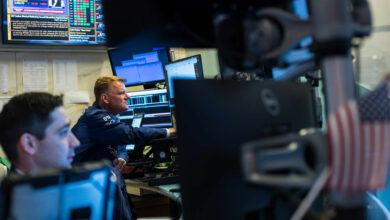Cash may feel safe when stocks slide, but it has risks

Investors are often tempted to move their money into cash during times of stock market volatility. While cash may seem like a safe option compared to stocks, it can also present risks for long-term savers, according to financial advisors.
Cash, whether held in a high-yield savings account or a money market fund, is less volatile than stocks in the short term. However, historical data shows that cash typically delivers lower returns than stocks over the long term. Keeping excess cash instead of investing it can hinder investors from achieving their long-term financial goals.
In a paper analyzing stock and cash returns, Vanguard highlighted that investors with a cash-heavy portfolio may struggle to reach their investment objectives, potentially requiring them to save more of their discretionary income.
Recent market turmoil, fueled by tariff and trade disputes, led many investors to seek refuge in perceived safe havens, causing a significant shift from stocks to conservative assets like money market funds and bonds. The S&P 500 experienced its worst two-day decline since the early days of the Covid-19 pandemic, prompting a surge in 401(k) plan trading towards more conservative options.
While cash offers liquidity for emergencies and major expenses during market upheavals, it has a history of providing negative real returns after adjusting for inflation. In contrast, stocks have the potential for higher growth over the long term but come with inherent risks.
Financial advisors recommend a balanced approach to allocating cash and stocks in a portfolio. During the accumulation phase, individuals should hold enough cash for emergencies and upcoming expenses, while the remainder can be invested in stocks and bonds based on their risk tolerance and time horizon.
For those approaching retirement, it’s essential to maintain a cash reserve for immediate income needs and major purchases, with the rest of the portfolio diversified across fixed income and equities. Even retirees should have a portion of their portfolio allocated to stocks to ensure sustainable growth over their retirement years.
Having a well-defined investment strategy that outlines the allocation to equities, fixed income, and cash is crucial for investors to navigate through market uncertainties. Sticking to this strategy through market fluctuations is key to long-term financial success.
In conclusion, while cash may offer stability in the short term, investors should carefully weigh the trade-offs between cash and stocks to achieve their long-term financial goals. Balancing liquidity needs with investment growth is essential for building a resilient and sustainable investment portfolio. In today’s fast-paced world, technology is advancing at an exponential rate. From the rise of artificial intelligence to the development of self-driving cars, the possibilities seem endless. One of the most exciting areas of technological innovation is the field of virtual reality (VR).
Virtual reality is a computer-generated simulation of an environment that can be interacted with in a seemingly real or physical way. This technology has been around for decades, but recent advancements have made VR more accessible and immersive than ever before.
One of the key drivers of VR innovation is the gaming industry. With the release of popular VR headsets such as the Oculus Rift and HTC Vive, gamers can now experience their favorite games in a whole new way. Instead of just watching the action unfold on a screen, players can now step into the virtual world and interact with it in real-time.
But VR is not just limited to gaming. It has applications in a wide range of industries, from healthcare to education to architecture. For example, medical students can use VR simulations to practice surgical procedures in a safe and controlled environment. Architects can use VR to walk through a virtual building before it is even constructed, allowing them to make adjustments and improvements before breaking ground.
One of the most exciting developments in VR is the use of haptic feedback technology. This technology allows users to feel and touch objects in the virtual world, adding a whole new level of immersion to the experience. For example, a VR headset paired with haptic gloves can simulate the sensation of picking up a virtual object or feeling the texture of a virtual surface.
As VR technology continues to evolve, the possibilities for its use are endless. From training simulations to virtual tourism to therapy for PTSD patients, VR has the potential to revolutionize how we interact with the world around us. And with the continued advancements in hardware and software, VR is becoming more accessible and affordable for consumers and businesses alike.
In conclusion, virtual reality is a technology that is rapidly changing the way we experience the world. With its immersive and interactive capabilities, VR has the potential to transform industries and enhance our daily lives in ways we never thought possible. So strap on your headset and get ready to experience the future of technology with virtual reality.





